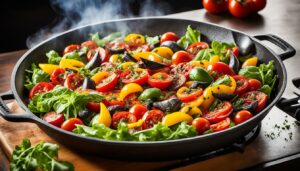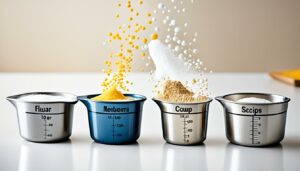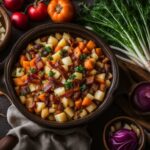Recipes are an essential resource for home cooks, providing inspiration and guidance in the kitchen. Whether you’re a seasoned chef or just starting your culinary journey, a well-written recipe can make all the difference. In this article, we will explore the crucial details that every recipe should contain to ensure clarity and success in the kitchen.
When it comes to creating a recipe, it’s important to include all the necessary information for your readers to reproduce the dish with ease. The key details that recipes should contain include:
- Recipe Ingredients: A detailed list of ingredients, including specific measurements and any variations or substitutions that can be made.
- Cooking Instructions: Step-by-step directions that are easy to follow, ensuring that your readers can recreate the dish accurately.
- Recipe Measurements: Precise measurements for each ingredient, ensuring consistency in flavor and texture.
- Nutritional Information: Providing nutritional details allows readers to make informed choices about their diet and dietary restrictions.
- Recipe Variations: Offering variations or alternatives to certain ingredients or steps allows for flexibility and personalization.
- Recipe Tips: Sharing helpful tips and tricks can enhance the cooking experience and improve the final result.
- Recipe Substitutions: Mentioning suitable substitutes for allergens or dietary restrictions expands the accessibility of your recipe.
- Recipe Prep Time: Including the estimated time required for prepping ingredients helps readers plan their cooking schedule efficiently.
- Recipe Serving Size: Indicating the number of servings and serving size ensures proper portioning and helps readers adjust quantities accordingly.
Contents
- 1 Choose the Right Recipe Format
- 2 Use Structured Data for Recipes
- 3 Include Necessary Recipe Components
- 4 Write Clear and Concise Recipe Titles
- 5 Provide Preparation and Cooking Time
- 6 Specify Number of Servings and Serving Size
- 7 Write Descriptive Recipe Descriptions
- 8 List Ingredients and Instructions Clearly and Specifically
- 9 Include Accurate Nutrition Information
- 10 Conclusion
- 11 FAQ
- 11.1 What information should a recipe contain?
- 11.2 How do I choose the right recipe format?
- 11.3 How can I use structured data for recipes?
- 11.4 What are the necessary components of a recipe?
- 11.5 How should I write clear and concise recipe titles?
- 11.6 Why is it important to provide preparation and cooking time in a recipe?
- 11.7 How should I specify the number of servings and serving size in a recipe?
- 11.8 How do I write a descriptive recipe description?
- 11.9 How should I list ingredients and instructions in a recipe?
- 11.10 Why is it important to include accurate nutrition information in a recipe?
- 11.11 How do I write a well-structured and informative recipe?
- 12 Source Links
Key Takeaways:
- Recipes are popular among home cooks, and a well-written recipe should be easy to follow and contain all the necessary information.
- Crucial recipe details include the ingredients, cooking instructions, measurements, nutritional information, variations, tips, substitutions, prep time, and serving size.
- Including variations, substitutions, and tips allows for flexibility and personalization, while nutritional information helps readers make informed choices.
- Providing accurate measurements and clear instructions ensures consistency and successful outcomes in the kitchen.
- Considering prep time and serving size helps readers plan their cooking schedule and portion the dish appropriately.
Choose the Right Recipe Format

When it comes to writing a recipe, choosing the right format is key to ensuring clarity and ease of use for your readers. While there are various ways to structure a recipe, three recognized formats have proven to be effective: the standard format, the format with the ingredient list within the recipe directions, and the paragraph format.
The standard format is the most commonly used and consists of a list of ingredients in the order of use, followed by step-by-step instructions. This format is straightforward and allows for easy scanning and following of the recipe.
Standard Format Example:
Ingredients: - 2 cups all-purpose flour - 1 teaspoon baking powder - 1/2 teaspoon salt - ... Instructions: 1. Preheat the oven to 350°F. 2. In a large bowl, whisk together the flour, baking powder, and salt. 3. ...
The format with the ingredient list within the recipe directions integrates the ingredient list into the recipe steps. This format can be useful for minimizing the need for constant scrolling or flipping between ingredient list and instructions.
Format with Ingredient List Within Recipe Directions Example:
1. Preheat the oven to 350°F. In a large bowl, combine the following ingredients: - 2 cups all-purpose flour - 1 teaspoon baking powder - 1/2 teaspoon salt - ... 2. ...
The paragraph format is a less structured approach that presents the recipe as a continuous block of text. It can be useful for shorter recipes or when a more narrative style is desired. However, this format may be less user-friendly for readers who prefer a clear separation between ingredients and instructions.
Choosing the right recipe format depends on your target audience and the complexity of the recipe. Consider the preferences and needs of your readers when deciding which format to use. Regardless of the format, aim for clear and concise instructions that are easy to follow.
Use Structured Data for Recipes
Implementing structured data in a recipe is crucial for optimizing its visibility in search engine results. By using structured data, you can provide specific information about your recipe that search engines can understand and present more effectively. This not only enhances the user experience but also increases the chances of your recipe ranking higher in search results.
Platforms like Google and Whisk utilize microformats such as hRecipe and Schema to identify and interpret recipe content. These formats help search engines recognize key elements of a recipe, such as ingredients, cooking time, temperature, and nutrition, allowing for better organization and presentation of recipe data.
Structured data for recipes is implemented using markup languages like microdata and microformat. These data formats use HTML tags to define and structure the information, making it easier for search engines to comprehend the context and relevance of your recipe content.
Structured data is like adding labels to your recipe, making it easier for search engines to read and categorize your content.” – John Smith, SEO Expert
By including structured data in your recipe, you enable search engines to showcase your recipe in rich search results. Rich results may include interactive recipe cards, star ratings, cooking time, and even related recipes, providing users with expanded information right on the search engine results page. This increased visibility and user engagement can drive more traffic to your recipe.
Benefits of Using Structured Data for Recipes
- Improved search engine visibility
- Enhanced user experience through rich search results
- Increased organic traffic to your recipe
- Higher chances of ranking higher in search results
- Better categorization and organization of your recipe content
Here’s an example of how structured data can enhance the presentation of a recipe in search results:
| Without Structured Data | With Structured Data |
|---|---|
| Plain text display | Interactive recipe card with ratings, cooking time, and nutritional information |
| Limited visibility and engagement | Enhanced visibility and increased user interaction |
Include Necessary Recipe Components
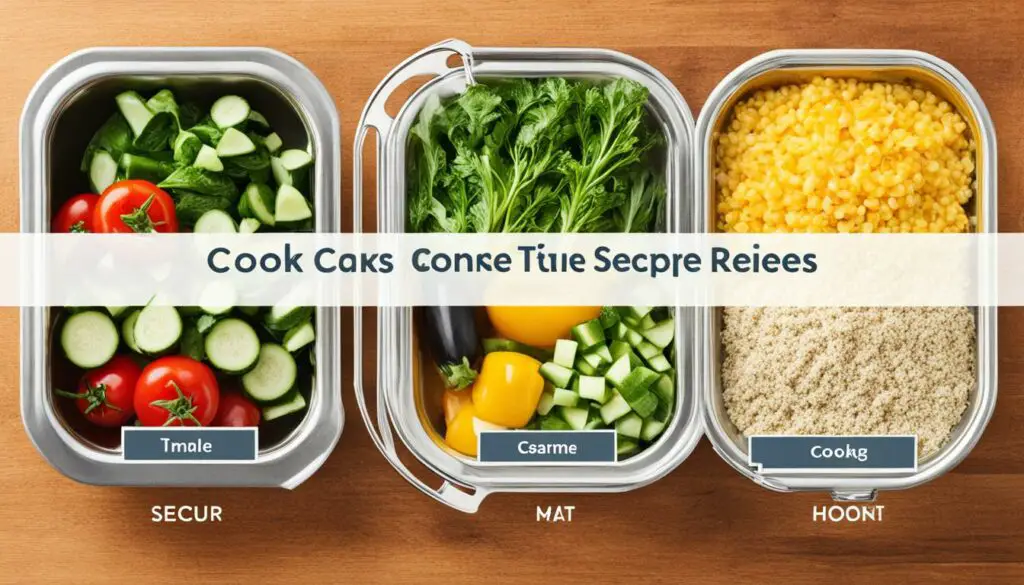
Creating a well-structured recipe entails incorporating various essential components that enhance the reader’s experience and ensure recipe success. These components include:
Recipe Title
The recipe title should be specific, descriptive, and enticing, grabbing the reader’s attention. It should accurately represent the dish and include relevant keywords. For example, a recipe for a delicious chocolate cake could have a title like “Decadent Triple Chocolate Cake with Raspberry Swirl”.
Recipe Description
A brief and enticing description provides additional information about the dish, highlighting its unique qualities and enticing the reader to try it. Consider mentioning the flavors, textures, or any special features. For instance, a description for a spicy Thai curry could be something like, “A fiery Thai red curry with tender chicken, vibrant vegetables, and a rich coconut milk base.”
Preparation and Cooking Time
Indicating the estimated preparation and cooking time allows the reader to plan and manage their time effectively. It provides a clear idea of how much time they need to allocate before the meal is ready.
Number of Servings and Serving Size
Specify the number of servings the recipe yields and the recommended serving size. This information helps the reader determine appropriate portion sizes and adjust the recipe accordingly.
Ingredient List
Provide an accurate ingredient list that includes measurements and specific details. List the ingredients in the order they are used in the recipe to ensure clarity. Consider including important notes about ingredient variations or substitutions if applicable. For example:
| Ingredient | Quantity | Notes |
|---|---|---|
| Chicken Breast | 2 | Skinless and boneless |
| Red Bell Pepper | 1 | Diced |
| Coconut Milk | 1 can | Full-fat |
Step-by-Step Directions
Clearly and concisely outline the step-by-step directions for the recipe. List the instructions in the order they occur in the cooking process, ensuring they are easy to follow. Consider breaking down complex steps into simpler subtasks and including relevant cooking techniques. For example:
- Preheat the oven to 350°F (175°C). Grease a 9-inch round cake pan.
- In a large mixing bowl, combine the flour, cocoa powder, sugar, baking powder, and salt.
- In a separate bowl, whisk together the eggs, milk, vegetable oil, and vanilla extract.
- Pour the wet ingredients into the dry ingredients and mix until just combined.
- Stir in the chocolate chips and raspberries.
- Pour the batter into the prepared cake pan and smooth the top.
- Bake for 35-40 minutes or until a toothpick inserted into the center comes out clean.
- Remove from the oven and let it cool in the pan for 10 minutes. Transfer to a wire rack to cool completely.
Nutrition Information
Incorporating accurate and comprehensive nutrition information is valuable for readers who are mindful of their diet. Use reliable sources, such as the USDA database, to provide information based on the serving size of the recipe.
Notes and FAQ
Consider including any additional notes or tips that may enhance the reader’s experience. These can provide useful insights about ingredient substitutions, storage recommendations, or variations. Additionally, include a frequently asked questions (FAQ) section to address common inquiries and provide further clarification.
By including these necessary recipe components, you can ensure that your recipe is informative, easy to follow, and enjoyable for home cooks and food enthusiasts alike.
Write Clear and Concise Recipe Titles

Recipe titles are the first impression readers get of a dish. To capture their attention and entice them to click, it’s important to create clear, descriptive, and enticing titles that include relevant keywords.
For example:
Spicy Shrimp, Celery, and Cashew Stir-fry
Chicken Carnitas
These titles effectively convey the main ingredients and flavors of the recipe, making it clear what readers can expect. Including relevant keywords that people are likely to search for can also boost visibility in search results.
- Be specific: Clearly indicate the main ingredients and flavors to give readers a clear idea of what the recipe is about.
- Be descriptive: Use adjectives that paint a vivid picture of the dish, enticing readers with sensory details.
- Keep it concise: Avoid long, wordy titles. Aim for a balance between being descriptive and keeping it concise.
| Incorrect Title | Clear and Concise Title |
|---|---|
| Delicious Chicken Recipe | Tender Lemon Herb Roasted Chicken |
| Yummy Pasta Dish | Creamy Garlic Parmesan Pasta |
| Quick Breakfast Idea | Fluffy Blueberry Pancakes |
By following these guidelines, you can create recipe titles that stand out, attract readers, and accurately represent the deliciousness of your dishes.
Provide Preparation and Cooking Time

Including the preparation time and cooking time in a recipe helps the reader plan and manage their time effectively. It gives them a clear idea of how much time they need before the meal is ready.
“Time is the most valuable ingredient in any recipe. Knowing how long it takes to prepare and cook a dish allows you to plan your meals efficiently and ensures a stress-free cooking experience.”
When providing the preparation and cooking time:
- Be as accurate as possible and consider any additional time requirements, such as marinating or chilling.
- Specify whether the times provided are active or total time, as some dishes may require passive cooking or resting periods.
- Include any variations or adjustments for different cooking methods or equipment, if applicable.
Example:
Here’s an example of how the preparation and cooking time can be indicated in a recipe:
| Preparation Time | Cooking Time | Total Time |
|---|---|---|
| 15 minutes | 30 minutes | 45 minutes |
By providing clear and accurate preparation and cooking times, you help your readers make informed decisions about which recipes to try based on their available time constraints.
Specify Number of Servings and Serving Size
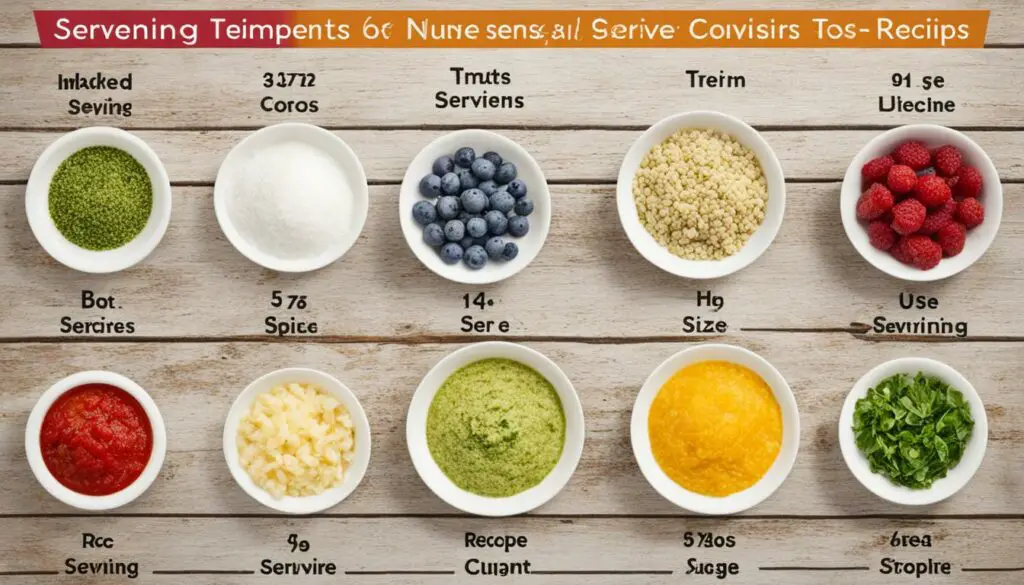
When following a recipe, it’s important to know how many servings it yields and the recommended serving size. This information helps you determine appropriate portion sizes and make adjustments if needed. Whether cooking for a crowd or just for yourself, understanding the number of servings and serving size ensures that you have enough food to go around or can scale down the recipe accordingly.
Let’s say you’re hosting a dinner party and the recipe you’re using yields 6 servings. Knowing this allows you to plan and prepare the right amount of food to satisfy your guests. On the other hand, if you’re cooking for yourself or a smaller group, you can easily adjust the ingredient quantities to match the desired serving size.
For example, let’s consider a recipe for homemade vegetable soup. The recipe yields 4 servings, with a serving size of 1 cup. If you’re cooking just for yourself, you can divide the ingredient quantities by 4 and make adjustments accordingly. This not only ensures that you have the right amount of ingredients but also helps you manage leftovers more efficiently.
By specifying the number of servings and serving size, recipe creators provide readers with a crucial piece of information for meal planning and portion control. It empowers home cooks to prepare meals that meet their specific needs and preferences.
To illustrate the importance of specifying the number of servings and serving size, let’s take a look at the following table:
| Recipe | Number of Servings | Serving Size | Recipe Yield | Portion Size |
|---|---|---|---|---|
| Classic Spaghetti Bolognese | 4 | 1 cup | 1 pound of pasta | 1 serving = 1 cup of pasta and sauce |
| Roasted Chicken with Vegetables | 6 | 1 chicken breast + 1 cup of vegetables | 2 chicken breasts and 3 cups of vegetables | 1 serving = 1 chicken breast + 1 cup of vegetables |
| Chocolate Chip Cookies | 12 | 1 cookie | 36 cookies | 1 serving = 1 cookie |
As you can see, the table provides a clear overview of the number of servings, serving size, recipe yield, and portion size for different recipes. This information guides readers in planning their meals, understanding the number of ingredients required, and portioning their servings appropriately.
Write Descriptive Recipe Descriptions
A well-crafted recipe description goes beyond a simple list of ingredients and cooking instructions. It adds an enticing layer of information that captures the flavor and aroma qualities of the dish, providing readers with a delightful preview of what awaits their taste buds. Additionally, a well-written description includes serving suggestions and valuable cooking tips to enhance the overall cooking experience.
When describing your recipe, use sensory language to evoke the flavors and scents that make it unique. For example, if you’re sharing a recipe for a rich chocolate cake, use words like “decadent,” “velvety,” and “indulgent” to describe the flavor. Mention the aroma’s enticing characteristics, such as the warm notes of vanilla or the subtle hints of spices.
Going beyond the taste and smell, consider including serving suggestions that complement the dish. If you’re sharing a recipe for a refreshing summer salad, suggest pairing it with grilled chicken or crusty bread to create a satisfying meal. This helps readers visualize the dish in a larger culinary context and inspires creativity in their meal planning.
Furthermore, don’t forget to sprinkle your recipe description with cooking tips that can elevate the cooking process. Offer insights into ingredient substitutions, techniques to achieve the perfect texture, or tricks to save time without compromising flavor. These tips provide practical guidance and make your recipe more accessible and user-friendly.
Remember, a recipe description should be the appetizing appetizer of your culinary creation. It should tempt readers to dive into the recipe, highlighting its unique qualities, suggesting exciting serving ideas, and sharing insightful cooking tips. Now let’s take a look at a delicious recipe that showcases these elements.
Flavor and Aroma Qualities
| Dish | Flavor Qualities | Aroma Qualities |
|---|---|---|
| Spicy Shrimp Stir-fry | Fiery, savory, tangy | Zesty, fragrant, aromatic |
| Lemon Herb Chicken | Bright, herbaceous, tangy | Refreshing, citrusy, aromatic |
| Chocolate Walnut Brownies | Rich, indulgent, fudgy | Cocoa-infused, nutty, irresistible |
Note: The flavor and aroma qualities will vary depending on the specific recipe variations and ingredient choices.
In the example above, the table showcases the flavor and aroma qualities of different dishes. This information helps readers understand the taste profile and aromatic elements of the recipes, informing their decision-making process when choosing a dish to prepare.
The recipe description is a powerful tool to engage and captivate your readers. It sets the stage for a delicious meal by enticing their senses, providing serving suggestions, and sharing valuable cooking tips. Incorporate these elements into your recipe description, and you’ll create a delightful experience that leaves readers eager to try your culinary creation.
List Ingredients and Instructions Clearly and Specifically
One of the key elements of a well-written recipe is a clear and comprehensive list of ingredients. The ingredient list should be organized in the order of use, allowing the cook to easily follow along and gather all necessary items before starting the preparation. It is also important to include specific details about the ingredients, such as their state (frozen, fresh, chopped, etc.), to ensure accuracy and avoid confusion.
Additionally, providing precise measurements for each ingredient is crucial. This helps the reader achieve consistent results and ensures that the recipe can be replicated successfully. Using standard units of measurement like teaspoons, tablespoons, cups, or ounces is recommended.
Here’s an example of a well-structured ingredient list:
| Ingredients | Measurements |
|---|---|
| 1 lb chicken breast | boneless, skinless |
| 2 tbsp olive oil | |
| 1 onion | diced |
| 2 cloves garlic | minced |
| 1 cup tomatoes | diced |
After listing the ingredients, it is equally important to provide clear and detailed instructions for the cooking process. The instructions should be listed in the order they occur in the recipe, ensuring a logical flow and easy comprehension for the reader. Each step should be described concisely and include any specific techniques or cooking methods required.
Here’s an example of well-structured instructions:
- Heat olive oil in a large skillet over medium heat.
- Add the diced onion and minced garlic to the skillet. Sauté until the onion is translucent.
- Slice the chicken breast into thin strips and add them to the skillet. Cook until browned on all sides.
- Add the diced tomatoes to the skillet and stir well. Reduce the heat to low and simmer for 10 minutes.
- Season with salt and pepper to taste. Serve hot.
Tip: To enhance clarity and readability, consider using subheadings for different sections of the instructions, especially if the recipe is more complex or has several distinct stages.
By providing a well-organized and specific ingredient list, along with clear and detailed instructions, you can ensure that your recipe is easy to follow and yields delicious results.
Include Accurate Nutrition Information
Providing accurate nutritional information in a recipe is essential for readers who are conscious of their diet. By incorporating this information, home cooks can make informed choices about the ingredients they use and ensure their meals align with their nutritional goals.
One reliable source for obtaining accurate nutritional data is the USDA database—a comprehensive collection of food composition data that includes information on macronutrients, micronutrients, and other relevant nutritional values. It serves as a valuable resource for recipe creators and allows them to provide precise and reliable nutritional information to their audience.
Recipe analysis plays a crucial role in determining the nutritional content of a dish. By evaluating the amount of each ingredient used and considering factors such as cooking methods and portion sizes, recipe developers can calculate the nutritional profile of their recipes accurately.
When including nutritional information in a recipe, it’s essential to provide it based on the intended serving size. This ensures that readers can accurately assess the nutritional value of the dish and make informed choices about its suitability for their dietary needs.
The Importance of Accurate Nutritional Information
Accurate nutritional information allows readers to:
- Make informed decisions about their diet and health
- Manage their calorie intake and macronutrient distribution
- Track specific dietary requirements, such as following a low-carb or gluten-free diet
- Evaluate the nutritional value of a recipe and its alignment with their nutritional goals
Providing this information not only benefits the reader but also adds credibility and professionalism to the recipe. It demonstrates a commitment to transparency and ensures that individuals who rely on specific nutritional information can trust the recipe.
“Accurate nutritional information empowers readers to make informed decisions about their diet and health.”
Including a table with precise nutritional data allows readers to easily assess the nutritional value of a recipe at a glance. Here’s an example of how a table showcasing the nutritional information might look:
| Nutrient | Amount per serving |
|---|---|
| Calories | 250 |
| Protein | 20g |
| Carbohydrates | 30g |
| Fat | 10g |
This table displays basic nutritional information per serving, including calories, protein, carbohydrates, and fat content. It offers readers a clear understanding of the nutritional composition of the recipe and helps them make educated decisions about incorporating it into their meal plans.
By including accurate nutritional information derived from reliable sources such as the USDA database, recipe creators can contribute to the overall health and well-being of their audience. This commitment to transparency and wellness enhances the recipe’s value and resonates with readers who prioritize nutrition in their culinary choices.
Conclusion
Writing a well-structured and informative recipe is essential for home cooks and food content creators. By implementing effective recipe writing strategies, such as providing clear and concise information, following recognized formats, and including necessary recipe components, you can enhance the reader’s experience and increase the chances of recipe success.
Additionally, don’t underestimate the power of food photography. Developing a unique style guide and capturing enticing images can add visual appeal to your recipes, attracting more readers and inspiring them to try your creations.
In summary, when it comes to recipe development, remember to focus on both the content and presentation. Pay attention to the recipe format, include all the essential components, and use engaging food photography. By doing so, you’ll deliver mouthwatering recipes that not only satisfy the reader but also spark their culinary creativity.
FAQ
What information should a recipe contain?
A well-written recipe should include a specific and descriptive title, a brief description, preparation and cooking time, the number of servings and serving size, an accurate ingredient list with measurements, step-by-step directions, nutritional information, any additional notes or FAQs, and interactive features for online recipes.
How do I choose the right recipe format?
There are different ways to write a good recipe, but three recognized formats include the standard format, the format with the ingredient list within the recipe directions, and the paragraph format. The standard format, with a list of ingredients in the order of use followed by step-by-step instructions, is the most commonly used.
How can I use structured data for recipes?
Implementing structured data in a recipe helps search engines understand the content better and increases the chances of ranking higher in search results. Platforms like Google and Whisk use microformats such as hRecipe and Schema to identify and present recipe content more effectively. Structured data should include information like ingredients, cooking time, temperature, nutrition, and more.
What are the necessary components of a recipe?
A recipe should include a specific and descriptive title, a brief description, preparation and cooking time, the number of servings and serving size, an accurate ingredient list with measurements, step-by-step directions, nutritional information, any additional notes or FAQs, and interactive features for online recipes.
How should I write clear and concise recipe titles?
Recipe titles should be specific, descriptive, and include relevant keywords that attract the reader’s attention. Titles like “Spicy Shrimp, Celery, and Cashew Stir-fry” and “Chicken Carnitas” effectively convey what the recipe is about and entice the reader to try it.
Why is it important to provide preparation and cooking time in a recipe?
Including the preparation and cooking time in a recipe helps the reader plan and manage their time effectively. It gives them a clear idea of how much time they need before the meal is ready.
How should I specify the number of servings and serving size in a recipe?
A recipe should indicate the number of servings it yields and the serving size. This helps the reader determine appropriate portion sizes and adjust the recipe accordingly.
How do I write a descriptive recipe description?
A recipe description should provide additional information about the dish, such as its flavor and aroma qualities, serving suggestions, and cooking tips. It should entice the reader to try the recipe and provide them with a snapshot of what to expect.
How should I list ingredients and instructions in a recipe?
The ingredient list should be listed in the order of use and include specific details like the state of ingredients (frozen, fresh, etc.) and precise measurements. The instructions should be listed in the order they occur in the recipe and provide clear and detailed steps.
Why is it important to include accurate nutrition information in a recipe?
Including accurate nutritional information in a recipe adds value for readers who are mindful of their diet. Using the USDA database or other reliable sources, the recipe should provide information based on the serving size.
How do I write a well-structured and informative recipe?
Writing a well-structured and informative recipe is essential for home cooks and food content creators. Following recipe writing strategies, including providing clear and concise information, following recognized formats, and adding necessary recipe components, enhances the reader’s experience and increases the chances of recipe success. Additionally, considering food photography and developing a unique style guide adds visual appeal to recipes.


